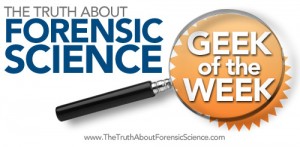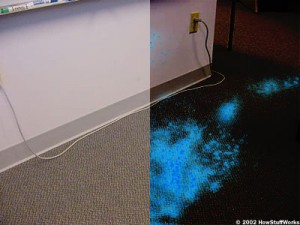The Forensic Science Geek of the Week
The week 34 “www.TheTruthAboutForensicScience.com Forensic Science Geek of the Week” honors goes to:
Ralph R. Ristenbatt, III
- The Week 34 Forensic Science Geek of the Week: Ralph R. Ristenbatt, III
- (follow him on Twitter too as PennStateCSI)
He describes himself as follows: Mr. Ristenbatt holds Bachelor of Science in Biochemistry (Lebanon Valley College) and a Master of Science in Forensic Science (John Jay College of Criminal Justice/CUNY). Dr. Peter R. De Forest mentored his graduate thesis research, An Evaluation of Pyrolysis/Supercritical Fluid Chromatography for the Individualization of Polyolefins.
In 1990, Mr. Ristenbatt accepted a position at the New York City Office of Chief Medical Examiner in the Department of Forensic Biology. His duties included serological and DNA (HLA-DQalpha) analysis of physical evidence recovered in homicide and sexual assault cases. In 1995, he was promoted to a supervisory position. As such, Mr. Ristenbatt was responsible for the validation, implementation, and supervision of FT-IR analysis of polydimethylsiloxane (PDMS), a lubricant used in condom manufacture. He has also received training in the analysis of gunshot residue (GSR) by scanning electron microscopy and energy dispersive X-ray analysis (SEM/EDX). Since 1991, Mr. Ristenbatt was responsible for the scientific analysis and reconstruction of crime scenes, production of reconstruction reports, and expert testimony in the five boroughs of New York City. In 2000, Dr. Robert C. Shaler formalized these operations into the Medical Examiner Scientific Assessment and Training Team (MESATT). Mr. Ristenbatt was the team supervisor of the MESATT. In 2003 the team changed its name to the Forensic Analysis and Reconstruction Unit (FARU). Mr. Ristenbatt supervised this team until his departure from city service in 2006. This scientific team examined and analyzed crime scenes with an end goal of reconstruction and it also provided training to law enforcement personnel in areas of biological evidence collection, bloodstain pattern analysis, crime scene/incident reconstruction, and forensic photography.
Mr. Ristenbatt holds certifications by the International Association of Identification (Senior Crime Scene Analyst) and the American Board of Criminalistics (Diplomate – Criminalistics) and he is a Fellow of the American Academy of Forensic Sciences. He has worked on over 300 reconstruction cases and has testified approximately 50 times (25 in the area of crime scene reconstruction). Mr. Ristenbatt, with others, has instructed over fifteen 40-hour bloodstain pattern analysis courses for personnel from agencies including the NYPD Crime Scene Unit, FBI Evidence Response Team (Newark, NJ), New Jersey State Police, New York State Police, and other jurisdictions.
Mr. Ristenbatt has also been an Adjunct Lecturer at Pace University (Westchester) and John Jay College of Criminal Justice/CUNY in an undergraduate/graduate criminalistics laboratory course and undergraduate laboratory courses of forensic chemistry and introductory forensic science. In 2006, he accepted his current position with the Forensic Science Program at the Pennsylvania State University.
His recent CV can be found here: View Ralph R. Ristenbatt’s CV
Ralph R. Ristenbatt, III is Week 34’s www.TheTruthAboutForensicScience.com Forensic Science Geek of the Week!
Congratulations to our Week 34 winner!
All hail the www.TheTruthAboutForensicScience.com Forensic Science Geek of the Week!!!
See the challenge question that our winner correctly answered.
OFFICIAL QUESTION:
1. What is the blue appear to be an example of?
2. For what reason does it turn blue?
3. What are the limitations of this type of evidence?
Please visit the www.TheTruthAboutForensicScience.com FaceBook fan page.
Our Geek of the Week answered:
1. Blue “glow” appears to be chemiluminescence.
2. Blue chemiluminescence is produced when hemoglobin in blood catalyzes the decomposition of a peroxide to form free oxygen. The free oxygen reacts with luminol. At the end of the reaction cascade, the luminol has been transformed to an excited state molecule. The excited state molecule returns to the ground state accompanied by the emission of light.
3. Limitations include production of “false positives” (dependent upon application method) with several different materials including metals and oxidizers (cleaning agents, etc.) and dilution of small quantities of blood, which may affect subsequent DNA analysis.
[BLOGGER’S NOTE: Honorable mention should go to four other folks who answered the question well…
Jason Glass, Esquire wrote: “I will take a stab at it. It appears to be luminol which is sprayed on a surface to detect the presence of any trace amounts of blood even after a suspect has attempted to clean it off of the surface. As for the limitations of luminol, I would suspect that it is not exactly specific for solely blood.” This was correct-ish and hence the honorable mention.
Chuck Ramsay, Esquire who wrote:
“1. What is the blue appear to be an example of?
It appears to be latent traces of blood exposed by luminol.
2. For what reason does it turn blue?
A light-producing chemical reacts between several chemicals and hemoglobin, an oxygen-carrying protein in the blood. The molecules break down and the atoms rearrange to form different molecules. In this particular reaction, the reactants have more energy than the products (the resulting molecules). The molecules get rid of the extra energy in the form of visible light photons. This process is generally known as chemiluminescence.
The “central” chemical in this reaction is luminol (C8H7O3N3), a powdery compound made up of nitrogen, hydrogen, oxygen and carbon. Criminalists mix the luminol powder with a liquid containing hydrogen peroxide (H2O2), a hydroxide (OH-) and other chemicals, and pour the liquid into a spray bottle. The hydrogen peroxide and the luminol are actually the principal players in the chemical reaction, but in order to produce a strong glow, they need a catalyst to accelerate the process. The mixture is actually detecting the presence of such a catalyst, in this case the iron in hemoglobin.
Criminalists spray the mixture wherever they think blood might be. If hemoglobin and the luminol mixture come in contact, the iron in the hemoglobin accelerates a reaction between the hydrogen peroxide and the luminol. In this oxidation reaction, the luminol loses nitrogen and hydrogen atoms and gains oxygen atoms, resulting in a compound called 3-aminophthalate. The reaction leaves the 3-aminophthalate in an energized state — the electrons in the oxygen atoms are boosted to higher orbitals. The electrons quickly fall back to a lower energy level, emitting the extra energy as a light photon. With iron accelerating the process, the light is bright enough to see in a dark room.
3. What are the limitations of this type of evidence?
a. Luminol only shows investigators that there might be blood in an area, since other substances, including household bleach, can also cause the luminol to glow.
b. The chemical reaction caused by luminol can destroy other evidence in the crime scene.
*** Justin — Thanks for leaving the clue to “HowStuffWorks.com” on the photo!”
Robert Lantz,, Ph.D. who wrote:
“It appears to be an example of a luminol reaction with a blood stain. Luminol reacts with nacent oxygen to form an unstable compound that emits the somewhat characteristic blue chemiluminencence. The initial reaction (oxygen formation) is catalyzed by iron (e.g. hemoglobin), copper and a few other things, including other enzymes in plants and animals. However, bleaching agents (hypochlorite most commonly) can also cause the luminol to react and obliterate anything of evidentiary value.
Think of “luminol” as a more sensitive (and less toxic) version of benzidine or reduced phenolphthalein reagents.”
and
Christine Funk, Esquire who wrote:
“First, sorry about your travel nightmare. You can trade stories with some of our MN people who are supposed to be here now and may not be here until Tuesday. . .
1. What is the blue appear to be an example of? Ummmm, an example of what happens when you don’t rip up the carpet and install some lovely linoleum on top of the sub floor after someone has bled – a LOT – on your carpet. . . And then the cops come in and apply luminol to the surface.after you spent hours cleaning? I mean, that’s just one example!
2. For what reason does it turn blue? chemiluminescence – A chemical reaction that occurs when the luminol comes in contact with an oxidant.
3. What are the limitations of this type of evidence? “An oxidant” can be the iron in blood. But it can also be iron in other things, bleach, copper, also cyanides. Also, spraying luminol must be done ‘evenly’ or it will skew the results. Finally, it only ‘glows in the dark’ for 30 seconds or so.”
You all are great! Thanks for answering too!]
The Hall of Fame for the www.TheTruthAboutForensicScience.com Forensic Science Geek of the Week:
Week 1: Chuck Ramsay, Esquire
Week 2: Rick McIndoe, PhD
Week 3: Christine Funk, Esquire
Week 4: Stephen Daniels
Week 5: Stephen Daniels
Week 6: Richard Middlebrook, Esquire
Week 7: Christine Funk, Esquire
Week 8: Ron Moore, B.S., J.D.
Week 9: Ron Moore, B.S., J.D.
Week 10: Kelly Case, Esquire and Michael Dye, Esquire
Week 11: Brian Manchester, Esquire
Week 12: Ron Moore, B.S., J.D.
Week 13: Ron Moore, B.S., J.D.
Week 14: Josh Lee, Esquire
Week 15: Joshua Dale, Esquire and Steven W. Hernandez, Esquire
Week 16: Christine Funk, Esquire
Week 17: Joshua Dale, Esquire
Week 18: Glen Neeley, Esquire
Week 19: Amanda Bynum, Esquire
Week 20: Josh Lee, Esquire
Week 21: Glen Neeley, Esquire
Week 22: Stephen Daniels
Week 23: Ron Moore, B.S., J.D.
WEEK 24: Bobby Spinks
WEEK 25: Jon Woolsey, Esquire
WEEK 26: Mehul B. Anjaria
Week 27: Richard Middlebrook, Esquire
WEEK 28: UNCLAIMED, IT COULD BE YOU!!!!
WEEK 29: Ron Moore, Esquire
WEEK 30: C. Jeffrey Sifers, Esquire
WEEK 31: Ron Moore, Esquire
WEEK 32: Mehul B. Anjaria
WEEK 33: Andy Johnston
WEEK 34: Ralph R. Ristenbatt, III




